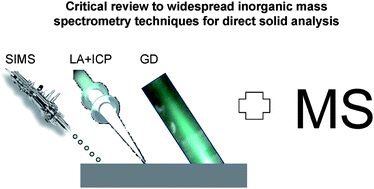Critical revision of GD-MS, LA-ICP-MS and SIMS as inorganic mass spectrometric techniques for direct solid analysis
Abstract
Inorganic mass spectrometric techniques and methods for direct solid analysis are widely required to obtain valuable information about the multi-elemental spatial distribution of the major and trace constituents and/or isotope ratio information of a sample in a wide variety of solid specimens, including environmental wastes, biological samples, geochemical materials, coatings and semiconductors. The increasing need to characterize complex materials in industry (e.g. production control and quality assurance processes), and in different fields of science is forcing the development of various inorganic mass spectrometric methods for direct solid chemical analysis. These methods allow the characterization of solid materials both in bulk and in spatially resolved analysis (with lateral and/or in-depth resolution). This review critically discusses the analytical performance, capabilities, pros and cons, and trends of


 Please wait while we load your content...
Please wait while we load your content...